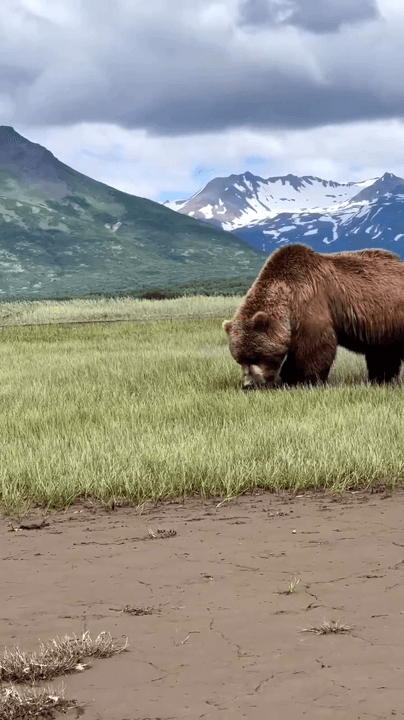
Alaska's Majestic Bears: A Guide to Understanding These Iconic Giants Discover Alaska's diverse bear population, including grizzlies, black bears, and polar bears. Learn about their habitats, behavior, safety tips, and how to observe them responsibly. Alaska, the Last Frontier, is renowned for its breathtaking landscapes, abundant wildlife, and, most notably, its impressive bear population. These magnificent creatures hold a significant place in Alaska's ecosystem and cultural heritage. From the formidable grizzly to the adaptable black bear and the Arctic-dwelling polar bear, Alaska offers a unique opportunity to witness these iconic animals in their natural habitat. This article delves into the world of Alaskan bears, providing insights into their characteristics, behavior, and how to safely and responsibly appreciate their presence. Types of Bears in Alaska: Alaska is home to three main types of bears: Grizzly Bear (Brown Bear): Often referred to as brown bears, grizzlies are the largest and most powerful land predators in Alaska. They are characterized by their prominent shoulder hump (a mass of muscle for digging), long claws, and dish-shaped face. Coastal brown bears, thriving on salmon runs, can grow to immense sizes. Grizzlies are omnivorous, with a diet that includes berries, roots, insects, fish, and mammals. They are most active during the day (diurnal) but can adjust their behavior to avoid human contact. Black Bear: The most common bear species in Alaska, black bears are found in forested areas throughout the state. Despite their name, their fur can range in color from black to brown, cinnamon, or even blonde. They are generally smaller than grizzlies and lack the distinctive shoulder hump. Black bears are opportunistic feeders, consuming a wide variety of plants, fruits, insects, and small animals. Polar Bear: Found primarily in the Arctic regions of Alaska, polar bears are highly specialized for life in the icy environment. They have thick fur, a layer of blubber for insulation, and large paws for navigating snow and ice. Polar bears are primarily carnivores, relying heavily on seals for sustenance. Climate change and the loss of sea ice are significant threats to their survival. Bear Habitat and Distribution: Grizzly Bears: Found throughout Alaska, with higher densities in areas with abundant food sources like salmon streams and berry patches. Black Bears: Found in forested areas across Alaska, excluding some areas of the Arctic. Polar Bears: Found along the Arctic coast of Alaska, primarily near sea ice. Bear Behavior and Ecology: Understanding bear behavior is crucial for both appreciating these animals and ensuring your safety. Here are some key aspects: Hibernation: During the winter months, bears enter a state of dormancy to conserve energy. They reduce their metabolic rate, heart rate, and breathing. While not true hibernation, this period allows them to survive when food is scarce. Diet: Bears are opportunistic omnivores. Their diet varies depending on the season and availability of food. Social Structure: Bears are generally solitary animals, except for mothers with cubs. Communication: Bears communicate through scent marking, body language, and vocalizations. Bear Safety Tips: Alaska is bear country, and taking precautions is essential when exploring the outdoors. Here are some important safety tips: Make Noise: Hike in groups and make noise to alert bears to your presence. Singing, talking loudly, or using bear bells can help. Carry Bear Spray: Bear spray is a highly effective deterrent against aggressive bears. Know how to use it properly and keep it readily accessible. Store Food Properly: Store food in airtight containers and hang it between trees, at least 10 feet off the ground and 4 feet from the trunk. Avoid Attracting Bears: Do not leave food scraps or garbage behind. Be Aware of Your Surroundings: Pay attention to signs of bear activity, such as tracks, scat, and claw marks on trees. Never Approach a Bear: If you encounter a bear, remain calm, slowly back away, and avoid direct eye contact. Responsible Bear Viewing: Seeing a bear in its natural habitat can be an unforgettable experience. Here are some guidelines for responsible bear viewing: Maintain a Safe Distance: Observe bears from a safe distance using binoculars or a spotting scope. Do Not Feed Bears: Feeding bears is illegal and can habituate them to humans, leading to dangerous encounters. Respect Their Space: Avoid approaching bears, especially mothers with cubs. Support Sustainable Tourism: Choose tour operators that prioritize bear conservation and responsible wildlife viewing practices. Conservation Efforts: Protecting Alaska's bear population is crucial for maintaining the health of the ecosystem. Various organizations and agencies are involved in bear research, habitat conservation, and public education. These efforts help ensure that future generations can appreciate these magnificent animals. Conclusion: Alaska's bears are a symbol of the state's wild beauty and untamed spirit. By understanding their behavior, respecting their habitat, and following safety guidelines, we can coexist with these incredible creatures and ensure their continued survival in the Last Frontier. Plan your visit responsibly, be prepared, and marvel at the majestic bears of Alaska. #Alaska #Bears #Grizzly #Bear #BrownBear, #BlackBear
Post: 12 February 23:38

